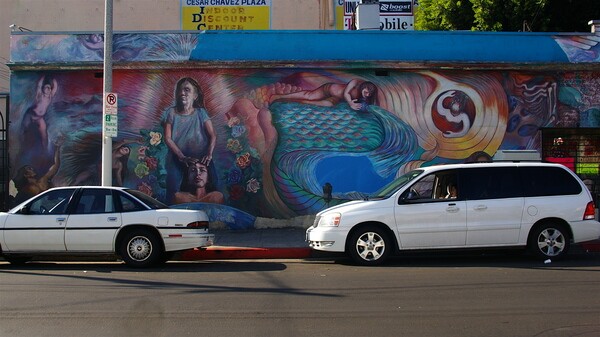Film Student's Short Documentary Covers L.A.'s Mural Plight
"Behind The Wall: The Battle For LA's Murals," a six-minute documentary directed by Oliver-Riley Smith, is now posted on Vimeo. His short 2010 film, while covering what many Angelenos know about its own murals, deftly introduces the art issue to a larger audience.
Opening with soft music and lingering pans of murals on Broadway and the city's ethnic enclaves--many works commissioned through SPARC's Neighborhood Pride Program--the voiceover by muralist Ernesto De la Loza introduces the plight of L.A.'s murals as works lost by graffiti and censorship by the city.
"What the hell is going on here," said the muralist once he appears on camera, standing in front of his 1991 work "Resurrection of the Green Planet," located at the corner of Brooklyn Ave and Breed in Boyle Heights.
The piece, like the others in the opening montage, is heavily tagged.

The mural, sometimes known simply as "Resurrection," is aptly nicknamed since it can be credited as one of the high profile works that brought attention to the complicated rules and ordinances preventing murals to be restored and saved.
In November 2008, the building owner was warned by the City Of Los Angeles he would be fined within 90 days if he did not cleaning up the graffiti, or paint over the wall. Knowing the value of the work to the neighborhood, De la Loza was brought in to be given a chance to restore the almost two decade old mural.
In November 2008, Eastside based blogger El Random Hero came across the artist, who began restoration with his own money.
The story was soon picked up by the Los Angeles Times, who wrote "A truce once existed between artists and taggers -- artists created public art without the danger of losing their work to turf-minded youth. But the relationship has eroded as new gangs have taken to the streets, looking for any available space to mark their territory."
The iconic 15-by-50-foot mural, wrote the Times, is anchored by "a curandera, or healer, touches the head of a young woman, whose eyes appear closed in peaceful resignation. The rich brown of the woman's skin pops against the red and orange of a healing aura surrounding them."
The image used as the centerpiece is Mexican photographer Graciela Iturbide's 1988 "Curacíon, Juchitán, Oaxaca."
In the film, the theme of city censorship is illustrated by De la Loza showing lost murals, including the CRA whitewashing one of his pieces to "gentrify the neighborhood."
The film doesn't retreat from placing the burden of mural destruction on street art. It follows graff artist Ghost One into the Los Angeles River, who tells the camera the technique of painting a name on a mural gives a tag longevity.
That is a statement well known by muralist and stakeholders, and as in the film, usually brings on a comparison of money spent to eradicate tags versus restoring murals.
A short documentary can't delve into that complication, but it does allow works (that what would be qualify as Vintage Murals under ordinances in progress) to be further identified as community based works.
Completed in 2009 under the umbrella of the USC Film and Television MFA program, Smith's micro-doc became a UK entry, and one of 24 nominated, for the Delphic Art Movie Award 2011. That selection came from a field of 134 documentaries under 10 minutes that seek "the fascination" of arts and cultures.
Recently, Smith was selected as a "Brit To Watch" in 2011 by BAFTA, which made him a featured guest during the Royal Couple's visit to Downtown Los Angeles.
The British ear of the filmmaker captured a telling moment of the relationship between the traditional mural form and the immediate neighborhood. In Spanish, the artist introduced himself to an older man passing by and asks him how he feels about the tagging.
"They are taking our culture away," said the man, the sadness in his tone not lost in translation.


